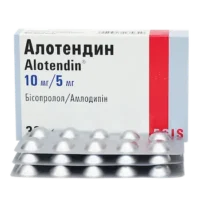Description
Zocardis Plus (Zofenopril Calcium, Hydrochlorothiazide) Coated Tablets 30/12.5 mg. №28
Ingredients
- Each coated tablet contains zofenopril calcium 30 mg and hydrochlorothiazide 12.5 mg.
Dosage
- The recommended dosage is one tablet daily, or as directed by a healthcare professional.
Indications
- Zocardis Plus tablets are indicated for the treatment of hypertension in patients who require dual therapy.
Contraindications
- Do not use Zocardis Plus if you are allergic to any of the ingredients, have a history of angioedema related to previous ACE inhibitor therapy, or have severe renal impairment.
Directions
- Swallow the tablet whole with a glass of water. It can be taken with or without food.
Scientific Evidence
Zofenopril, the ACE inhibitor component of Zocardis Plus, effectively lowers blood pressure and reduces cardiovascular events in patients with hypertension. Hydrochlorothiazide, a diuretic, complements the antihypertensive effects of zofenopril by promoting diuresis and reducing blood volume.
Clinical trials have shown the efficacy of zofenopril in reducing the risk of stroke, myocardial infarction, and cardiovascular mortality. The combination of zofenopril and hydrochlorothiazide in Zocardis Plus provides a synergistic effect in managing hypertension and improving cardiovascular outcomes.
Additional Information
- Monitor electrolyte levels and renal function regularly while taking Zocardis Plus, especially in patients with renal impairment.
- Avoid concomitant use of potassium-sparing diuretics, potassium supplements, or salt substitutes containing potassium.
- If you experience symptoms such as swelling of the face, lips, throat, or difficulty breathing, seek immediate medical attention as these may indicate a serious allergic reaction to the medication.





